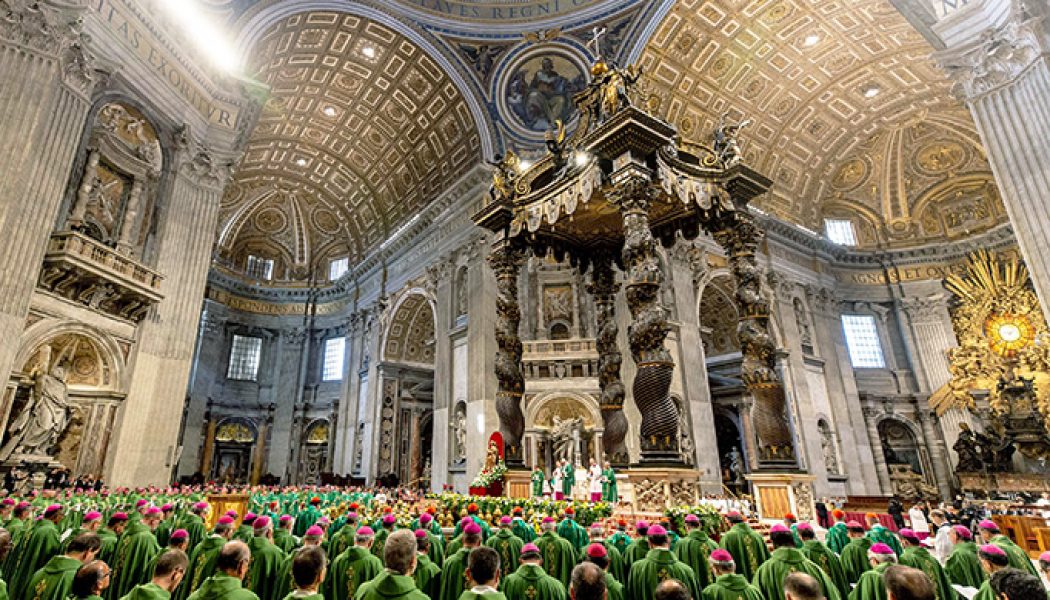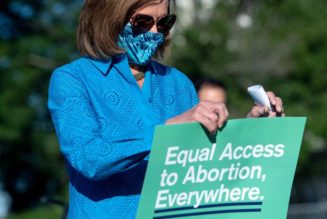
Pope Francis celebrated the closing Mass of the Synod of Bishops for the Pan-Amazon region, in St. Peter’s Basilica, Oct. 27, 2019. (Daniel Ibáñez/CNA)
This would have been the most likely time of his pontificate for Pope Francis to endorse viri probati, women deacons or an Amazonian rite — yet he declined to do so.
On Feb. 12, Pope Francis released a document responding to the October 2019 Synod of Bishops on the Amazon.
The document has been expected for several months and has been the subject of intense speculation on several controversial topics.
These included proposals to ordain married men to the priesthood, to ordain women to the permanent diaconate, and to create a special Amazonian rite with its own form of liturgy.
Pope Francis did not accept any of these proposals.
Here are 8 things to know…
What is the Synod of Bishops?
The Synod of Bishops is a gathering of bishops from around the world that meets periodically. Since it first convened in 1967, it has met about once every two years.
Its purpose is to discuss how the Church can best respond to particular pastoral issues. In some cases, these deal with challenges the Church faces in particular regions, such as the Amazon.
The Synod typically meets for a few weeks, at the conclusion of which the attending bishops issue a document summarizing their reflections and making various proposals. This document is submitted to the pope for his consideration, and in recent years the document has been made public.
Following the Synod, the pope then prepares his own document — known as a “post-synodal apostolic exhortation” — in which he discusses the subjects the Synod took up and makes determinations for future courses of action.
What happened in this case?
The Synod of Bishops met Oct. 6-27. In attendance were several hundred bishops, mostly drawn from the nine countries in the Amazon region (Brazil, Bolivia, Colombia, Ecuador, Guyana, Peru, Surinam, Venezuela and French Guiana), along with a variety of nonvoting attendees.
The Synod’s final document is online here.
In 2018, Pope Francis provided that “if it is expressly approved by the Roman pontiff, the final document participates in the ordinary magisterium of the successor of Peter” (Episcopalis Communio, art. 18 §1).
While Pope Francis has spoken positively of the document, he has not given it the kind of formal approval needed to make it part of his personal magisterium.
After the Synod met, the Pope entrusted his advisers with drafting an apostolic exhortation, which he then reviewed and approved.
The new exhortation, which is titled Querida Amazonia (Spanish, “Beloved Amazon”) is available online here.
In my book Teaching With Authority, I commented on the nature of apostolic exhortations:
As the name suggests, these are documents in which the pope exhorts (urges, advises, counsels). They are pastoral rather than doctrinal in the formal sense, though they routinely restate Church doctrine. As teaching documents, they rank lower than encyclicals, though it would be inaccurate to represent them as non-magisterial documents. They also aren’t legislative and don’t create or modify laws. However, they can indicate how popes believe moral and canon law should be applied.
What does the new exhortation contain?
Apart from an introductory section and the customary Marian conclusion for documents like this, it contains four main sections, each of which describes a “dream” that Pope Francis has for the Amazon region. He describes them as follows:
I dream of an Amazon region that fights for the rights of the poor, the original peoples and the least of our brothers and sisters, where their voices can be heard and their dignity advanced.
I dream of an Amazon region that can preserve its distinctive cultural riches, where the beauty of our humanity shines forth in so many varied ways.
I dream of an Amazon region that can jealously preserve its overwhelming natural beauty and the superabundant life teeming in its rivers and forests.
I dream of Christian communities capable of generous commitment, incarnate in the Amazon region, and giving the Church new faces with Amazonian features (n. 7).
These dreams—which are later referred to as the “social dream,” the “cultural dream,” the “ecological dream,” and the “ecclesial dream”—are then described in the four chapters of the document’s main text.
A basic overview of the document is provided by Edward Pentin, but we will look at three topics that have been controversially globally—the ordination of married priests, the ordination of women to the diaconate and the creation of an Amazonian rite.
What has happened on the subject of married priests?
Citing the priest shortage in the Amazonian territory, which can cause communities to go months or years between the celebration of the Eucharist, the Synod’s final document proposed that an exception be made to the Latin Church’s general practice of ordaining only celibate (unmarried) men to the priesthood:
[W]e propose that criteria and dispositions be established by the competent authority [i.e., the Vatican], within the framework of Lumen Gentium 26, to ordain as priests suitable and respected men of the community with a legitimately constituted and stable family, who have had a fruitful permanent diaconate and receive an adequate formation for the priesthood, in order to sustain the life of the Christian community through the preaching of the Word and the celebration of the sacraments in the most remote areas of the Amazon region. In this regard, some [Synod fathers] were in favor of a more universal approach to the subject (n. 111).
In the period leading up to the release of Pope Francis’s exhortation, various online sources claimed to have seen drafts that endorsed this proposal. Other sources claimed to have seen drafts that did not do so.
When the exhortation was published, it did not make any mention of ordaining married men to the priesthood in the Amazon. Instead, it envisioned a renewed vocations campaign in the region. Pope Francis wrote:
This urgent need [for priests] leads me to urge all bishops, especially those in Latin America, not only to promote prayer for priestly vocations, but also to be more generous in encouraging those who display a missionary vocation to opt for the Amazon region (n. 90).
For the foreseeable future this effectively ends the idea of ordaining married men on an expanded basis in the Latin Church. Pope Francis received a request from a supermajority of the Synod’s bishops, and he chose not to accept the request.
This is not as surprising as it might be to some, as Cardinal Marc Ouellet—the head of the Congregation for Bishops—had previously hinted that Pope Francis was skeptical of the proposal.
What happened with respect to women deacons?
The Church’s Magisterium has infallibly taught that only men can be ordained to the priesthood. However, in 2002 Cardinal Joseph Ratzinger approved a document by the International Theological Commission that stated the Church has yet to “pronounce authoritatively” on the question of whether women could be ordained to the diaconate.
Consequently, in 2016 Pope Francis convened a commission to discuss this issue, though it reached inconclusive results.
The subject was further discussed at the Synod, whose final document stated:
In the many consultations carried out in the Amazon, the fundamental role of religious and lay women in the Church of the Amazon and its communities was recognized and emphasized, given the wealth of services they provide. In a large number of these consultations, the permanent diaconate for women was requested. This made it an important theme during the Synod. The Study Commission on the Diaconate of Women which Pope Francis created in 2016 has already arrived as a Commission at partial findings regarding the reality of the diaconate of women in the early centuries of the Church and its implications for today. We would therefore like to share our experiences and reflections with the Commission and we await its results (n. 103).
Following the Synod, Pope Francis said that he would reconvene the commission and allow further discussion of the topic. Given this statement, it is likely that this will happen.
However, no mention was made of ordaining women to the diaconate in the Pope’s exhortation, and the language it used was not encouraging toward the idea of ordaining women.
The document contains a five-paragraph discussion of the role of women in the Amazonian churches, but it distinctly downplays the idea of conferring holy orders on women. First, the Pope speaks positively of the role of women in the Amazon:
In the Amazon region, there are communities that have long preserved and handed on the faith even though no priest has come their way, even for decades. This could happen because of the presence of strong and generous women who, undoubtedly called and prompted by the Holy Spirit, baptized, catechized, prayed and acted as missionaries. For centuries, women have kept the Church alive in those places through their remarkable devotion and deep faith. Some of them, speaking at the Synod, moved us profoundly by their testimony (n. 99).
However, he cautions against the idea of conferring holy orders on women, continuing:
This summons us to broaden our vision, lest we restrict our understanding of the Church to her functional structures. Such a reductionism would lead us to believe that women would be granted a greater status and participation in the Church only if they were admitted to Holy Orders. But that approach would in fact narrow our vision; it would lead us to clericalize women, diminish the great value of what they have already accomplished, and subtly make their indispensable contribution less effective.
Jesus Christ appears as the Spouse of the community that celebrates the Eucharist through the figure of a man who presides as a sign of the one Priest. This dialogue between the Spouse and his Bride, which arises in adoration and sanctifies the community, should not trap us in partial conceptions of power in the Church. The Lord chose to reveal his power and his love through two human faces: the face of his divine Son made man and the face of a creature, a woman, Mary. Women make their contribution to the Church in a way that is properly theirs, by making present the tender strength of Mary, the Mother (n. 100-101).
Finally, he discusses the kind of positions and services that women should be given in the Amazon:
[T]hose women who in fact have a central part to play in Amazonian communities should have access to positions, including ecclesial services, that do not entail Holy Orders and that can better signify the role that is theirs. Here it should be noted that these services entail stability, public recognition and a commission from the bishop. This would also allow women to have a real and effective impact on the organization, the most important decisions and the direction of communities, while continuing to do so in a way that reflects their womanhood (n. 103).
What has happened with respect to an Amazonian rite?
The Synod’s final document contained a section titled “A Rite for the Indigenous Peoples,” which stated:
We should give an authentically catholic response to the request of the Amazonian communities to adapt the liturgy by valuing the original worldview, traditions, symbols and rites that include transcendent, community and ecological dimensions. . . .
It is urgent to form committees for the translation of biblical and the preparation of liturgical texts in the different local languages, with the necessary resources, preserving the substance of the sacraments and adapting their form, without losing sight of what is essential. . . .
The new organism of the Church in the Amazon should establish a competent commission to study and discuss, according to the habits and customs of the ancestral peoples, the elaboration of an Amazonian rite that expresses the liturgical, theological, disciplinary, and spiritual patrimony of the Amazon (nn. 116-119).
Pope Francis’s exhortation endorsed the idea—affirmed in many Church documents in recent decades—of “inculturating” various aspects of Church life (that is, adapting them based on the local culture).
However, he did not endorse the idea of creating a new rite for the Amazon. Instead, he wrote:
[W]e can take up into the liturgy many elements proper to the experience of indigenous peoples in their contact with nature, and respect native forms of expression in song, dance, rituals, gestures, and symbols. The Second Vatican Council called for this effort to inculturate the liturgy among indigenous peoples; over fifty years have passed and we still have far to go along these lines (n. 82).
In a footnote, he stated:
During the Synod, there was a proposal to develop an “Amazonian rite.”
This holds out the possibility that such a rite might develop in the future, but it does not endorse the idea of one being created now.
Could any of these ideas—married priests, women deacons or an Amazonian rite—come back in the future?
Of course. People proposed them now, and they can always re-propose them in the future. The question is what kind of papal reception they will have, and that depends on who the Pope at the time is.
If Pope Francis were to endorse any of these ideas in his pontificate, this was the most likely time for it, and he didn’t.
To appreciate this, it helps to realize that passages in the final document of a Synod need to be approved by a two-thirds majority of the bishops in attendance. A supermajority of the bishops selected to attend this Synod thus gave him direct invitations concerning each of these three proposals, and he chose not to follow up on them, despite the opportunity to do so.
In the future, he might reevaluate this, but his refusal to endorse any of these proposals is highly noteworthy.
It also appears that Pope Francis wishes to cool the expectations currently being generated in Germany as part of the “binding synodal path” their bishops have undertaken. Indeed, certain statements in the exhortation—particularly those in a section entitled “Expanding Horizons Beyond Conflicts”—can be read as directed against exaggerated German expectations, even though Germany is not mentioned. He writes:
It often happens that in particular places pastoral workers envisage very different solutions to the problems they face, and consequently propose apparently opposed forms of ecclesial organization. When this occurs, it is probable that the real response to the challenges of evangelization lies in transcending the two approaches and finding other, better ways, perhaps not yet even imagined (n. 104).
In light of the present rejection of three major pastoral proposals made at the Amazonian Synod, and tensions between the Vatican and the German bishops, it is easy to see this as a warning not to expect radical pastoral proposals made for a particular area to be accepted. and that “it is probable” that—in the long run—the actual path to be followed will be something else, perhaps “not yet even imagined.”
Cardinal Gerhard Müller has been critical of proposals connected with the Synod. What was his reaction to the apostolic exhortation?
He released a letter, in which he stated:
Amid great hopes and anxious fears, the post-synodal letter has arrived. It refers to the final document of the Amazon Synod on October 6-27, 2019, and the Pope does not draw from it any dramatic and disconcerting conclusions.
Rather, he wishes to offer the Church and all people of good will his own answers, in order to help to ensure a “harmonious, creative and fruitful reception of the whole synodal process” (Art. 2). . . .
The entire letter is written in a personal and attractive tone. The Successor of Peter, as the universal shepherd of Christ’s flock and as the highest moral authority in the world, wants to win all Catholics and Christians of other denominations, but also all people of good will for a positive development of this region, so that our fellow men and fellow Christians living there may experience the uplifting and unifying power of the Gospel.








